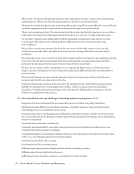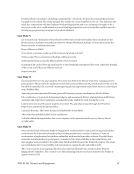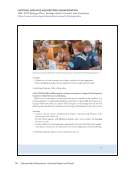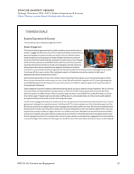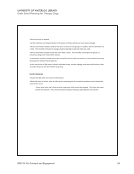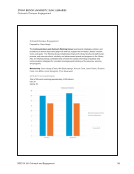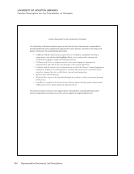3 SPEC Kit 361: Outreach and Engagement as a set of activities, it was unsurprising to see marketing and communications listed as an included component. Of note, eight respondents acknowledged that they have no formal definition of outreach for their institution. Some responses mentioned struggling with how to define outreach and noted a tension around whether to include typical liaison or subject librarian efforts, such as instruction or reference. While the definitions varied, there were many similarities in the populations upon which institutions focused their outreach efforts. Unsurprisingly, most of the respondents (54, or 95%) mentioned that they reach out to undergraduates at least six times per year. Other populations that received similar levels of outreach included graduate students (50, or 88%) and faculty (45, or 80%). However, institutions mentioned only providing outreach to staff one to three times a year, indicating that this could be an area of growth for many institutions. While external and community groups were still significant audiences, events targeted toward them occurred with less frequency. K-12 schools, particularly high schools, were an audience that many worked with, especially in association with larger academic efforts. The 36 respondents who selected “Other” often mentioned more granular audiences than were listed in the survey question. In addition, the survey asked about underserved groups or specific populations that respondents worked with. The most frequently targeted groups included international students (45, or 83%), first- generation students (33, or 61%), LGBTQIA+ patrons (29, or 54%), people of color (26, or 48%), people with disabilities (23, or 43%), and/or veterans (22, or 41%). Respondents were doing less outreach with underserved groups identified by the American Library Association Office of Diversity, Literacy, and Outreach Services, which included adult literacy patrons, incarcerated or ex-offenders, homeless people, and bookmobile users. In addition, few respondents reported that their libraries were doing outreach to commuter students. Of the 17 “Other” responses, K-12 and distance or online students were mentioned several times. Working to develop targeted outreach and engagement strategies can help meet institutional goals concerning retention, inclusion, and strategic plan initiatives. These efforts can be especially salient for at-risk and underserved populations. Outreach typically involves multi-pronged efforts to reach desired audiences throughout the year. Not surprisingly, the majority of respondents selected tours (56, or 98%), orientations (54, or 95%), open houses (55, or 96%), and resource tables (55, or 96%) as activities they have participated in over the past year. These could be viewed as the first point of contact for many users to learn about library services and programs. Author talks, film screenings, and friends of the library events were also noted as frequently used engagement activities, while scavenger hunts, gaming events, and virtual or self-guided tours were mentioned less often. Write-in responses commonly mentioned finals/de-stress and wellness activities such as crafts and therapy animals. Makerspaces and hack-a-thons are becoming popular in the literature as new ways to engage with audiences and were similarly reflected in the responses. Social media outreach was indicated by 95% of the respondents (55), but it was unclear if social media was used as a marketing tool for events and services or to connect with users through questions, contests, and other engagement strategies. Together this information paints a vibrant picture of outreach serving as a mechanism to communicate about library programs, services, and collections to the institution and community. Institutional Support This category of questions aimed to explore institutionalized support for library outreach. The level at which libraries provide structured and intentional support for outreach helps illustrate how closely outreach aligns with library priorities. First, respondents were asked if and how library mission and vision statements addressed outreach and engagement. Only 10 of the responding institutions (18%) indicated that outreach was not addressed in some fashion in mission and vision statements. Almost half of the responding institutions (27, or 48%) indicated that outreach was not explicitly mentioned













































































